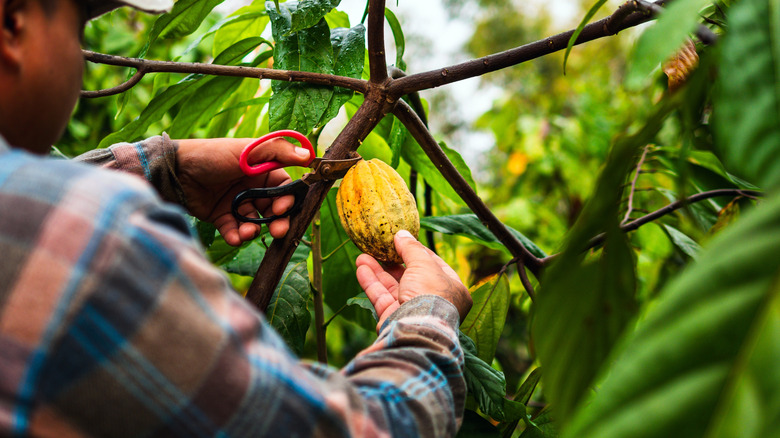The Difference Between Blended And Single-Origin Chocolate
Craft chocolate has boomed in popularity in recent years, and the market is forecast to continue growing. There is one key reason why craft chocolate has become so sought after, and it is not because there is one right way to eat it. Instead, it's thanks to the emergence of numerous exceptional single-origin chocolate products.
To put it simply, single-origin chocolate is chocolate that has been produced using one variety of cocoa bean sourced from within a single country. Some producers take it even further, sourcing their beans from a single region in that country or, as is increasingly the case, a single plantation in that country. The key benefit of using beans sourced from one area is that it gives chocolatiers an opportunity to create products that express terroir – the unique flavors created by an area's climate, soil composition, and various other factors.
In contrast, blended chocolate is produced using cocoa beans sourced from various countries. For example, a blended chocolate bar might be made using cocoa beans from both Ghana and Mexico. Such an approach ensures that it is impossible for the chocolate to express terroir. However, it does give chocolatiers a lot of control over the flavor profile of the chocolate, increasing product consistency. It is for this reason that many of the largest chocolate companies in the world sell blended chocolates (that are often made using proprietary cocoa blends). Another reason large companies tend to sell blended chocolate is that it's cheaper to make. This is reflected in the product's final price; single-origin chocolate tends to be much more expensive.
Is single-origin chocolate more ethical?
As all of the cocoa beans used to make single-origin chocolate are sourced from a single country, region, or plantation, the product is generally much more traceable than blended chocolate products. For many consumers, this is a huge plus, especially because the cocoa industry is still rife with exploitative working practices, such as slavery and child labor. What's more, this enhanced traceability also makes it easier to prove that the chocolate is being made in a sustainable way, something that, again, due to much more complex supply chains, companies producing blended chocolate products find harder to guarantee.
Single-origin chocolate offers some positives for those growing the cocoa too. For example, it is common for single-origin chocolate companies to pay farmers directly, cutting out the middlemen with the result that more money ends up in the farmers' pockets.
It is important to point out that a product being defined as single-origin chocolate does not guarantee that it has been produced in an ethical and sustainable manner. Likewise, some companies behind blended chocolate products have a reputation for exceptional traceability and ethics, such as Tony's Chocolonely. Ultimately, this means it is impossible to comprehensively state which type of chocolate is more ethical — it really depends on the company making it. In other words, it's on you to make sure you don't buy evil chocolate.

